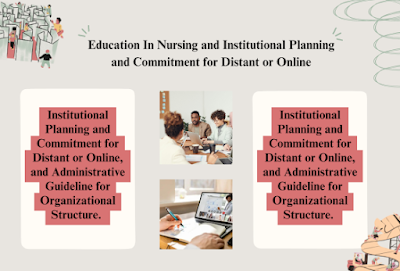The Institutional Planning and Commitment for Distant or Online Education In Nursing. Institutional commitment and planning are critical to the success of distance or online nursing education.
The Institutional Planning and Commitment for Distant or Online Education In Nursing
This requires a careful analysis of needs, economic feasibility, curricular alignment, and the ability to provide effective learning support. Furthermore, it is essential to ensure adequate technical infrastructure and address potential challenges such as student isolation.
1. Commitment to Online Education
At the institutional level, strategic decisions must be made regarding the commitment to online education. This includes the allocation of human, fiscal, and physical resources. Key areas to address include:
- Organizational and Administrative Infrastructure: Identifying who will oversee the development, implementation, and evaluation of online education programs.
- Funding Sources: Determining whether additional positions are needed for technical and instructional support, and how to sustain online education initiatives.
- Technology Support Services: Assessing whether to centralize or decentralize technology support and considering outsourcing options.
- Student Support Services: Ensuring adequate support for online learners, including 24/7 technical support to minimize downtime and frustration.
2. Funding and Sustainability
Online nursing programs often start with grant funding, but long-term sustainability requires additional financial strategies:
- Technology and Distance Education Fees: These may need to be introduced in addition to tuition fees to maintain online education programs.
- Cost Estimation Models: The University of Minnesota’s “good, better, best” model offers a framework for estimating online course development costs based on complexity and quality.
3. Technological Infrastructure
The institution must ensure its technological infrastructure can support online education effectively:
- Hardware and Software: Evaluating whether the current network system, bandwidth, and hardware meet the demands of online learning.
- Student Access: Considering the availability of broadband Internet in students’ geographic regions and planning content delivery accordingly.
4. Learning Management System (LMS) Selection
Selecting an appropriate LMS is crucial for the delivery and management of online courses:
- LMS Options: Institutions can choose from proprietary, open source, or cloud-based systems. Each has its advantages and disadvantages:
- Proprietary LMS: Offers professional support and technology but can be costly and less customizable.
- Open Source LMS: Such as Moodle and Sakai, are cost-effective and customizable but may lack integration and technical support.
- Cloud-Based Systems: Include tools like Facebook, iTunes U, and Skype but may require additional costs for advanced features and lack necessary authentication and security measures.
5. Contingency Planning
Contingency plans are necessary to handle issues beyond the institution’s control:
- Technical Problems: Addressing potential maintenance, shutdowns, or operational ceasing.
- Faculty and Student Development: Ensuring ongoing development for teaching and learning with technology, including intellectual property policies and support for course design and transition to online teaching.
6. Ongoing Institutional Planning
To ensure the success of online education efforts, institutional planning must be continuous and inclusive:
- Stakeholder Input: Engaging all stakeholders in planning efforts.
- Monitoring Trends: Staying updated on advancements in educational technology and adapting to emerging trends.
In summary, effective institutional planning and commitment are critical for the success of distance or online nursing education programs. Addressing these areas will help ensure that online learning initiatives are sustainable, well-supported, and capable of meeting the needs of both faculty and students.
Read More:
https://nurseseducator.com/didactic-and-dialectic-teaching-rationale-for-team-based-learning/
https://nurseseducator.com/high-fidelity-simulation-use-in-nursing-education/
First NCLEX Exam Center In Pakistan From Lahore (Mall of Lahore) to the Global Nursing
Categories of Journals: W, X, Y and Z Category Journal In Nursing Education
AI in Healthcare Content Creation: A Double-Edged Sword and Scary
Social Links:
https://www.facebook.com/nurseseducator/
https://www.instagram.com/nurseseducator/
https://www.pinterest.com/NursesEducator/
https://www.linkedin.com/in/nurseseducator/
https://www.researchgate.net/profile/Afza-Lal-Din
https://scholar.google.com/citations?hl=en&user=F0XY9vQAAAAJ

Наиболее стильные новинки подиума.
Актуальные мероприятия всемирных подуимов.
Модные дома, лейблы, высокая мода.
Новое место для модных хайпбистов.
https://kazantoday.ru/kznpub/2024-01-11-platnaya-parkovka-u-tsentralnogo-stadiona-v-kazani.html